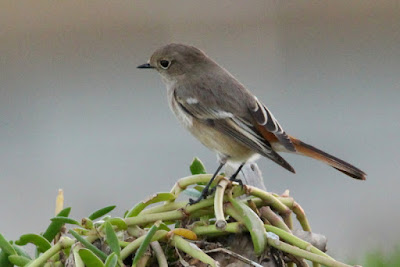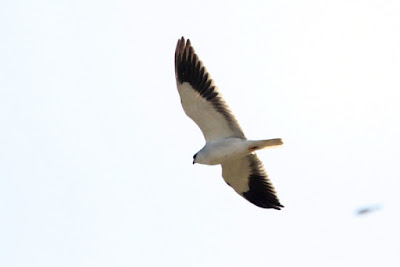Myself and Mashuq got a surprise when we discovered this female Eversmann's Redstart (15th for Kuwait) at Green Island, Kuwait City after observing some 27 Grey Hypocolius coming into roost on the island
The area where the Fish Market is
Heuglin's Gull
Caspian Gull
Steppe Gull
Slender-billed Gull
Local boatman throwing out fish for both the gulls and cats
And here the cats take over from the dogs
Asian Desert Warbler in a Kuwait City car park
The Great Black-headed Gull kept there distance at Doha Spit
Time was creeping upon us and we returned to the city to hopefully catch the Grey Hypocolius coming into roost on Green Island. The light was good when we arrived at 15.30 but we had to wait another thirty minutes before we observed a flock of 27 Grey Hypocolius perch nearby. In the last hour of light we got cracking views of this superb looking bird as they fed just before goin to roost. A Red-vented Bulbul was another bird we were hoping to connect with and we managed to get a single in the same trees as the hypocolius.
The Grey Hypocolius coming into roost
Up to 27 Grey Hypocolius came into roost on the island but not before they performed well for myself and Mush
Green Island is the only place to see this introduced species to Kuwait, Red-vented Bulbul
The resident White-cheeked Bulbul
In the fading light we found this Eversmann's Redstart at Green Island
DAY 5 Al Abraq
A new species for me was this Eurasian Scops Owl roosting at the farm
After finding the larks and redstart in the last two days, we didn't want our luck in discovering rare birds for Kuwait to end and we thought we would return to the ranch, Al Abraq, out in the middle of the desert, where many of rarities have been found including Mike Pope's only Western Palearctic record of Forest Wagtail!!
We got there as the sun was rising and immediately heard the 2 Hume's Warbler in the same area as last time at the entrance of the ranch. In the next hour it was pretty quiet and we were beginning to think if we had made the right move. We still decided to walk the whole of the ranch this time.
On the outskirts of the ranch on the desert part, 2 Corn Bunting, female Mallard and Sparrowhawk flew out west and we got good views of the Asian Desert Warbler again. It looked ideal for Black Redstart and it wasn't long before we were onto to a male Eastern Black Redstart. In the end there were 2 pairs but non of them showed well except the time when a male interacted with a female Siberian Stonechat.
Al Abrag Ranch out in the middle of the desert. Note the litter and you can't escape from it. You observe people throwing rubbish on the floor or out of the car window all the time.
The 2 Hume's Warbler showed much better than two days ago but not for the camera.
The female Siberian Stonechat, out of the blue, attacked the male Eastern Black Redstart. Unfortunately the sun was not behind me at the time.
Just up road, the male European Stonechat was still present
Back in the wooded part we could only find 3 of the 6 Penduline Tit and in small numbers we could hear Chiffchaff, Robin, Blackbird and Song Thrush. We also heard 2+Siskin on and off and Vagrant Emperors were all over the shop with lesser numbers of Red-veined Darter. While talking to Mush on one of the north tracks 'I've got a Scops Owl!' After scrutinise, what we could see of it, and try as we might, we couldn't turn it into a Pallid Scops Owl and it was finally identified as a Eurasian Scops Owl roosting in the Tammisk. Would you believe it was a new species for me and it was only a few meters above us. 'Bee-eater!' Mush shouted and it sounded like it was on the south side of the ranch. We immediately knew that it wasn't European Bee-eater and there were more than one. I had already ran off into the distance leaving Mush behind as it was another new species for me. Blue-cheeked Bee-eater but where the bloody ell was they. I heard them again but typical Bee-eaters proving mobile. I ran to where I heard them last, near to the desert part and briefly caught 2 Blue-cheeked Bee-eater above the trees only to fly off. It sounded like they had flown out SWW and despite searching for a while no sign off them and instead heard the Siskin again. Where were they?
We tried the pivot Fields nearby but no sign of any of the Calandra Lark. There were 50+Corn Bunting and a single Red-throated Pipit.
There were only 3 Penduline Tit
This Eurasian Scops Owl we observed for a good twenty minutes as it was a new species for me. The only reason we left it because I went chasing another new species, Blue-cheeked Bee-eater.
Just to the left of the track is where the Eurasian Scops Owl was rooster while on the left is where the Red-breasted Flycatcher favoured two days ago but no sign today.
Female Vagrant Emperor
Female Red-veined Darter
What on earth is this?? I reckon strange goins on in this farm!
Out in the Kuwaiti desert
Day 6 2 Crested Honey Buzzard
Maybe we didn't find anything yesterday but today we were fortunate to find 2 Crested Honey Buzzard including this adult female.
We arrived at the gates of the farm and were told to go and see Jacob in the office. That we did and after a chat over a coffee, we were given our own chauffeur who drove us around the area. As a result we went to sites where others can't go. This including how the farm works and they even brought out six of the Sheikh's falcons who are looked after on the farm. We were told that falcon chicks are taken from the wild, including Gyr. Then out of the three chicks, they train up the individual that they think is good at hunting bustards and let go of the others back into the wild!
The falcons were perched on stands in front of us were hybrids from Peregrine and Gyr and I'm sure there were others like Saker. Beautiful to see but very upsetting. Before we were shown the falcons, we were pointed out, as we drove past, that they had a Macqueen's Bustard scheme running. I thought great as these birds are on a sharp decline thanks to the love of your falcons hunting them. 'Yes, they are not many now in the wild so they are bred to be hunted by the Shaikh's falcons!!' I guess it's no different to back home in the UK where the Royal Parasites blood thirst continues to kill whatever they want. From wild animals in South Africa to 1000's of birds on their estates in the UK including grouse!!
The recent unusual heavy rains have played havoc on the farm as this bus struggled to pass
We were driven about and were surrounded by agricultural fields and off the main road we drove into one of the fields and at the side there were Caspian Stonechat and single Mauryan Grey and Daurian Shrike. In the air there were Black Kite, Great Spotted Eagle, Long-legged Buzzard and Pallid Swift. Then from nowhere, a juvenile female Crested Honey Buzzard flew through only to be followed by an adult female! A single would of been a great record for Kuwait but 2 Crested Honey Buzzard together may be a first record of two together in the winter!? Are luck was back with us and it continued when I heard a Richard's Pipit. It was when it called again that Mush picked it up and it flew off into the middle of the field. A Black-shouldered Kite hovered directly into the sun and then flew off NW. All this took place in some forty five minutes with 80+Lapwing in the same field.
This Mauryan Grey Shrike was sharing the same wires as a Daurian Shrike
Great Spotted Eagle
Juvenile Crested Honey Buzzard
Adult female Crested Honey Buzzard I've only ever seen two CHB before with singles in the Himalayas and in Thailand and by far, these two individuals today that we observed were the most impressive.
This Black-shouldered Kite was a good record
We were hoping to see the Sociable Plover that winter on the farm every year with the Lapwing and a few minutes drive and we found a small distant flock of Lapwing. A quick scan and we got 4 Sociable Plover and it wasn't long until they were in the air flying towards us. They landed deep in a field on the opposite side of the main road but that didn't stop us. Our chauffeur drove straight in the field and that was the problem. The plovers took off and returned to the field they had just come from. Shite!
We came to our second pond on the farm. the first one wasn't up to scratch but this was one was a little more productive with lots of Bluethroat and singing, Graceful Warbler. The latter species was another new species and I added another one a few minters later! A juvenile Eastern Imperial Eagle gave us cracking views before moving on with 4 Great Spotted Eagle and a our second Long-legged Buzzard of the day.
Good flight views of the 4 Sociable Plover with over 100 Lapwing I've only seen a single before this when an individual spent a week back on Scilly 100 years ago!
We had 2 long-legged Buzzard
And 2 Eastern Imperial Eagle at the same time
More Great Spotted Eagle were accounted included four together
We were coming to the end of our tour of the farm but not before we saw the bird we most wanted to see. As we drove along the main road, with a flood on one side, there at very close range were 27 White-tailed Plover! However, the sun was directly at the side instead of behind us and made it a little tricky to observe and take pics of the plovers. But hey! I'm not complaining. Oh yeah. They didn't really move. Just stood there front on. Except for maybe one that was side on until it thought it was the odd looking individual for being different to the others and it to decided to show itself front on. There were also 5 Wood sandpiper and 30+Black-tailed Stilt on the same flood.
A great morning spent on the farm and Jacob told us, as he said goodbye to us, that we are welcome anytime we like on the farm! Also many thanks again to Mike Pope. Follow his blog here and look at his amazing images http://kuwaitbirding.blogspot.com/
27 White-tailed Plover was the icing on the cake! After being only a stones throw away from the field where the Salop White-tailed Plover was suppressed from everyone for a five day stay back in 1984, I finally connected with some 27 birds!! I would of walked past that field, don't you know, when the plover was present.




























































































No comments:
Post a Comment